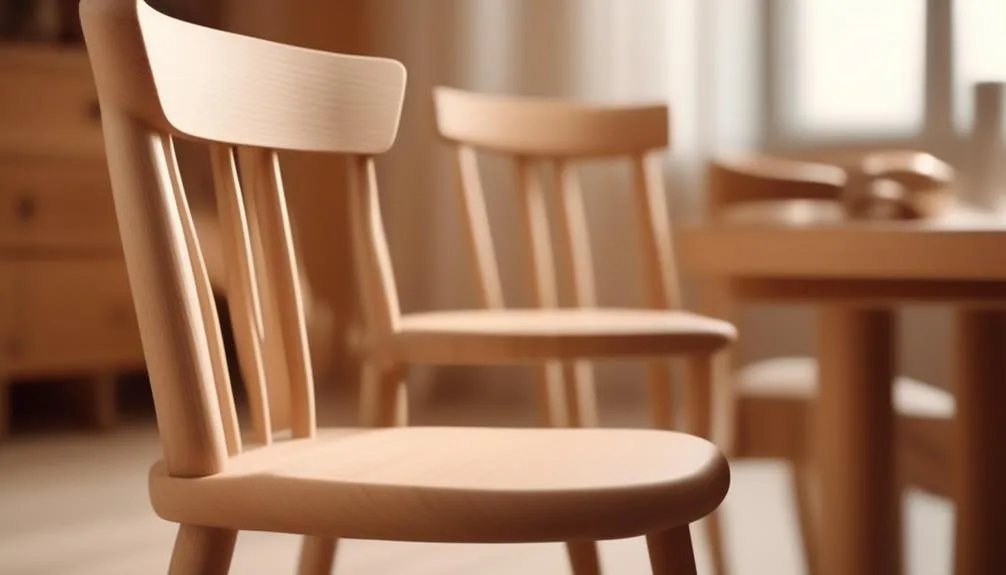Exploring furniture making and considering beech wood?
Let's examine its characteristics and see if it's the right choice for your project.
From strength and durability to aesthetic appeal, there's a lot to consider when using beech wood in furniture making.
Strength and Durability
When considering beech wood for furniture making, its strength and durability make it a reliable choice for long-lasting and sturdy pieces.
Beech wood is renowned for its longevity, requiring minimal maintenance to retain its quality and appearance.
Its robust nature ensures that furniture crafted from beech wood can withstand the test of time, making it an excellent investment for the future.
Despite its strength, beech wood remains relatively lightweight, allowing for easier handling during furniture construction and rearrangement.
This unique combination of strength and manageable weight contributes to the stability of beech wood furniture, ensuring that the pieces remain steadfast and reliable in everyday use.
With minimal upkeep and remarkable endurance, beech wood stands out as an ideal choice for creating enduring and dependable furniture pieces.
Workability and Versatility
Crafting furniture with beech wood is a rewarding experience due to its exceptional workability and versatility, allowing for intricate designs and diverse styles to be achieved effortlessly.
Its workability makes it easy to cut, shape, and mold, giving you the flexibility to create intricate details and unique furniture pieces.
Beech wood's versatility shines through its ability to take on various finishes, from stains and paints to natural oils, enabling you to achieve the perfect look for your furniture. Its smooth texture and fine grains make it an ideal canvas for different finishing options, enhancing the overall aesthetics of the furniture.
Whether you prefer a modern, rustic, or traditional style, beech wood's versatility makes it the perfect choice for bringing your furniture designs to life.
Aesthetic Appeal
With its warm, inviting color and distinctive grain patterns, beech wood exudes an aesthetic appeal that adds a touch of natural beauty to any furniture piece.
The subtle, pale cream hue of beech wood lends an air of elegance to furniture, complementing a wide range of interior design styles. Its smooth, fine texture and consistent grain make it an ideal choice for furniture with a modern, minimalistic aesthetic.
The aesthetic charm of beech wood lies in its ability to effortlessly blend into both traditional and contemporary settings, elevating the overall look of any space. Additionally, the design versatility of beech wood allows for intricate detailing and carving, making it suitable for creating ornate, decorative furniture pieces.
Whether used in its natural state or stained to enhance its color, beech wood adds timeless beauty to any furniture design.
Cost-Effectiveness
Are you looking for a wood that offers both durability and affordability for your furniture making needs? Beech wood might be the perfect choice. Here's why it's a cost-effective option:
- Abundant Availability: Beech wood is widely available, making it relatively more affordable compared to other hardwoods. This means you can acquire the raw materials at a lower cost, contributing to overall cost efficiency.
- Ease of Manufacturing: Its straight grain and fine, even texture make it easy to work with during the manufacturing process. This can result in reduced labor and machining costs, adding to the overall cost-effectiveness of using beech wood for furniture making.
- Longevity: Beech wood's natural durability ensures that the furniture crafted from it will last, providing value for money in the long run.
Environmental Considerations
When considering beech wood for furniture making, it's important to take into account its environmental impact and sustainability. Sustainable sourcing of beech wood involves ensuring that it's harvested in a responsible manner, promoting the long-term health of the forests. Beech wood is known for its relatively low carbon footprint compared to other woods, as it requires minimal processing and transportation due to its widespread availability in many regions.
Additionally, beech trees contribute to carbon sequestration, helping to mitigate climate change. When sourced sustainably, beech wood can be a more environmentally friendly choice for furniture making. By choosing beech wood from certified sustainable sources, you can contribute to the preservation of forests and reduce the environmental impact of furniture production.
Conclusion
In summary, beech wood offers a compelling combination of strength, durability, versatility, and aesthetic appeal, making it a favored choice for furniture making.
Its sustainable sourcing and long-lasting quality align with responsible consumer choices.
Consider the timeless and sustainable qualities of beech wood when selecting furniture materials.

My interest in trees started when I first saw the giant sequoias in Yosemite.
I was a teenager then, and I remember thinking, “I need to learn more about this.”
That moment stuck with me.
A few years later, I went on to study forestry at Michigan Tech.
Since graduating, I’ve worked in a mix of hands-on tree care and community education.
I’ve spent over ten years helping people understand how to plant, maintain, and protect the trees in their neighborhoods.
I don’t see trees as just part of the landscape.
They are living things that make a real difference in our daily lives.
